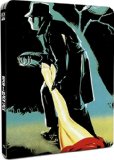| Reviews & Columns |
|
Reviews DVD TV on DVD Blu-ray 4K UHD International DVDs In Theaters Reviews by Studio Video Games Features Collector Series DVDs Easter Egg Database Interviews DVD Talk Radio Feature Articles Columns Anime Talk DVD Savant Horror DVDs The M.O.D. Squad Art House HD Talk Silent DVD
|
DVD Talk Forum |
|
|
| Resources |
|
DVD Price Search Customer Service #'s RCE Info Links |
|
Columns
|
|
|
Blood and Black Lace
Occasionally a remastered Blu-ray presentation comes along that can make you completely re-evaluate a film. Warner Bros. disc of Kubrick's 2001: A Space Odyssey and Synapse Films' Steelbook of Lamberto Bava's Demons come to mind. Now, with Arrow Video's long-awaited disc of Mario Bava's Blood and Black Lace (1964), there is another Blu-ray to add to that list as this edition made me appreciate the movie for the seminal masterpiece that it is.
Beginning on a rainy and windy night, a series of murders begin at a fashion house in Italy. Beautiful young models are viciously killed by a faceless man in a trench-coat and fedora. Could it be that the killer is trying to hide secret information contained inside a mysterious red journal? This fashion house is built on top of an old castle and the dark dungeons below reveal that under the surface of glitz and glamour, humanity's base barbarism hasn't gone away. The civility and elegance are just beautiful window dressings to cover over petty lies and savage brutality. Suspicion reads across all the characters' sweaty faces as twisty plot machinations give way to gloriously imaginative bursts of violence (rather tame by today's standards). Mario Bava uses his trademark cinematic ingenuity to craft a now timeless concoction of baroque images spiked with colorful, sometimes humorous murder set-pieces. This became the hallmark of Italian horror cinema of the seventies and a direct precursor of many of the American horror films of the eighties.
(CLICK ON THUMBNAILS TO SEE FULL RES)
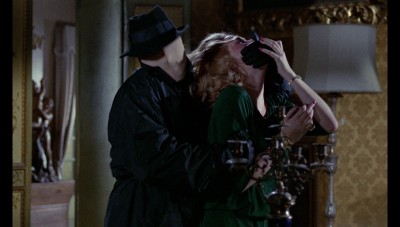
"Blood and Black Lace had, and still has, the visual impact of something wholly new. Here, the heightened hallucinatory color seems to burn with a psychotic fervor, the emotions and anxieties of its furtive characters reflected in its surface intensity." (Tim Lucas)
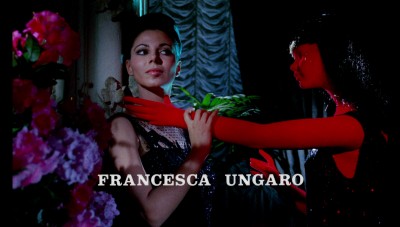
Most of my knowledge of Mario Bava, and everyone else's for that matter, comes from Tim Lucas of Video Watchdog. He is the premiere and perhaps only true scholar of Mario Bava's work and no Bava presentation is complete without liner notes or commentary from Tim Lucas. I remember becoming aware of Bava with the release of the Black Sunday and Black Sabbath Image DVDs. Lucas's essays helped put these films in the appropriate historical context. He's proven to be for Bava, and other filmmakers, what the truly great critics of any age are for artists. Lucas is both a champion preserving the legacy of Bava's output as well as the architect shaping the cultural framework by which we can understand the impact of that artist's work.
My first exposure to Italian horror cinema was Dario Argento's Suspiria, which I first saw on a friend's laserdisc. There is no doubt that Suspiria's visual splendor would not exist were it not for Blood and Black Lace. The vivid kaleidoscopic color scheme and the use of wind and rain to immediately create a wildly surreal mood in the opening scenes are just two of the more obvious links. Argento's Bird with the Crystal Plumage (1970) is thought by many to be the crystallization of what is now established in world cinema as the "Giallo" film. Named to match the yellow paperback pulp novels of the time, these stories took the noir genre and added in even more lurid details of sexuality and violence. Argento certainly ups the ante and experimented with the form in his own specific and dedicated way, but the invention of the tropes used must be credited more to Bava.
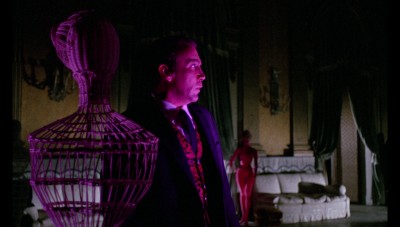
Bava knew he was shifting the form with Blood and Black Lace. It was believed by most filmmakers of the day that pulp films of this kind should be photographed in black and white. You can see this black and white standard in Clouzot's Diabolique, Hitchcock's Psycho, Bava's Black Sunday and Girl Who Knew Too Much as well as the films of his contemporaries Riccardo Freda and Antonio Margheriti. What Bava proved with both the "Telephone" segment of Black Sabbath and here with Blood and Black Lace was that expressive colors could add another dimension to the suspense and drama. (Note: rich color was something Roger Corman began experimenting with around the same time period with his Poe films for AIP.) Bava's use of color in these films is not as a stationary element, it vibrates with tension, pulsing like a heartbeat or obscuring our vision in a way that makes the viewer keenly aware the killer could appear at any moment. The key imagery in Bava's films invented a new formula that helped craft the Giallo subgenre in the minds of those who would later establish trends of their own such as Dario Argento, Lucio Fulci, Umberto Lenzi, and Sergio Martino amongst many others. Bava's ingenuity is perfectly emblematic of this incredibly creative time period in Italian genre cinema. With a fraction of the budgets of his American counterparts, Bava was doing his own in-camera special effects and lighting design. He could create the illusion of larger sets using matte paintings he crafted himself and on Blood and Black Lace he accomplished perfectly smooth, dizzyingly complicated camera balletics by mounting the camera to a child's red wagon. Genius is a word that often gets overused when describing filmmakers, however in Bava's case his technical and creative brilliance considering the tools he was working with really can't be understated.
Originally titled "The Fashion House of Death," Blood and Black Lace uses the Ten Little Indians structure of the body count picture which in turn inspired the biggest trend perhaps ever in American horror cinema of the 80's: the Slasher film. It's important to recognize that films such as Nightmare on Elm Street and Friday the 13th as well as the originality of now classic filmmakers such as John Carpenter and Brian De Palma would not exist if it wasn't first established by Italian genre filmmakers in the sixties and seventies. Although Bava's Twitch of the Death Nerve is probably more the direct link to Sean Cunningham's Friday the 13th, and Argento's Deep Red might be the most directly influential on Carpenter's Halloween, there's no doubt these guys were watching the films coming out of the Italian Giallo craze and were inspired by it while still bringing their own uniquely American visions to the formula.
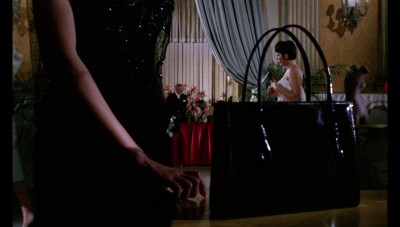
If you think of Scream as a sort of end point of the Slasher heyday, it's interesting to note a few links between what could arguably be the beginning and end of the cycle. Beyond the predictable connections of a masked killer and suspicious characters, both involve telephones as a key element of suspense, both mix self-conscious humor with violence and both have a clean almost purposely "phony" look (pun intended), though Blood and Black Lace is far more colorful. Also the means by which the murders occur is surprising similar, if you've seen both you'll know what I mean.
Like the Spaghetti Westerns of the time, Blood and Black Lace was acted by a multi-lingual cast and then dubbed for international audiences. So don't expect the performances to be subtley nuanced like one of the Italian Neo-Realists might have done. But even if it was subtle, that wouldn't be appropriate to this material, which is painted in broad garish brush strokes and maintains its candy-coated aesthetic on every level of its production. Instead of feeling "real" or "slice of life," the plot logic and acting styles function more to create the feeling a vivid dream or nightmare, fueled by apprehension, paranoia, conspiracy, degradation and vice (Michael Mackenzie). It's clear from this film and the others in Bava's filmography that he was more interested in imagery and tone than plot.
Film Noir reflected upon the changing roles of men and women in society after World War 2 and was a means for filmmakers and viewers to explore feelings like displacement, rage and confusion. Gialli use this framework, but then jump into the deep end of the psychological pool. Society in Film Noir, while possibly loose or decaying, still exists. In the Giallo, it's not really about corruption in the system so much as a complete loss of power in logic or morality. Though some later Gialli would provide a heroic, if untrustworthy, heroine or detective, Blood and Black Lace paints all the players as almost equally guilty or insane. There is an interplay between the subconscious and madness. Societal and sexual politics are felt in these films as a horror itself. What the Giallo subgenre understands very well that some modern horror films fail to grasp is that horror relies on the irrational. In Gialli, the world no longer makes any sense. The murders create an anarchy in which anyone can die, anyone can be the killer, and those being killed can be just as deceitful as the villain.
The Blu-ray:
Arrow offers either a collectible Steelbook edition or a standard special edition in clear clamshell casing with reversible cover art. This is a 3 disc set, one Blu-ray and 2 DVDs repeating the same content. The menu is attractive and colorful utilizing footage and music from the restored opening credit sequence on loop. Included is a 40 page collectible booklet containing cast and crew info, four articles about the film and some additional information about the short film Yellow as well as details about the new 2k transfer. It has beautiful color photos and a nice glossy finish. This is a quality set and the booklet functions well to enhance the experience of the film itself.
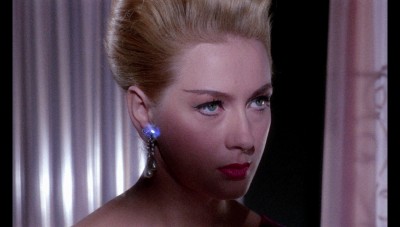
VIDEO:
The picture looks simply stunning. This new meticulous restoration looks nearly spotless and yet not waxy. It retains a beautiful amount of film grain and the colors pop brightly while skin tones remain natural. I reviewed my old anamorphic VCI DVD and the new 2K scan is a legendary upgrade. I'll be honest Blood and Black Lace was never my favorite Bava film to rewatch on DVD and now I can see that is largely due to it being such a visual film. Compared to this new Blu-ray the DVD is downright embarrassing. I don't say that as a mark against VCI. At the time, I was very pleased that they released both this film and Bava's The Whip and the Body on DVD. But this new remastered Blu-ray is THE version to own. "Blood and Black Lace (Sei donne per l'assassino) has been exclusively restored for this release by Arrow Films. The original camera negative was scanned in 2K resolution on a pin-registered Arriscan at Immagine Ritrovata, Bologna. The film was graded on the Baselight grading system at Deluxe Restoration, London. Thousands of instances of dirt, debris and scratches were removed through a combination of digital restoration tools. Image stability was also improved."
AUDIO:
The sound is equally strong. The track is clean and well represented. Available in Italian Mono with optional English Subtitles and English Mono. Even though this isn't a Dolby remix I think the crispness and clarity of this track is highly commendable. "The film's mono soundtrack was transferred from the original sound negative and audio issues such as pops, clicks and audible buzz were repaired, minimized or removed."
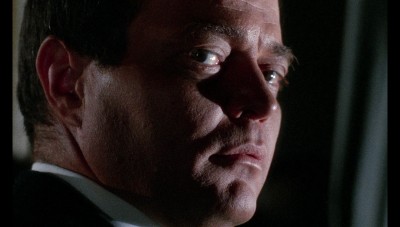
EXTRAS:
A wealth of extras, this is the most complete and comprehensive version of the film to date.
• Audio Commentary by Tim Lucas - Tim Lucas took his original audio commentary script from the VCI DVD and has now thoroughly revised it, keeping what he still found satisfactory and subtracting/correcting other data while adding new information acquired from subsequent interviews conducted over the roughly 12 years between recordings as well as new readings of scenes and other insights.
• Psycho Analysis (55:08) - A feature-length documentary on Blood and Black Lace and the origins of giallo, with directors Dario Argento and Lamberto Bava, screenwriter Ernesto Gastaldi, critics Roberto Curti and Steve Della Casa, crime novelist Carlo Lucarelli and others.
• Gender and Giallo (38:01) - A visual essay by Michael Mackenzie exploring the giallo's relationship with the social upheavals of 1960s and 1970s.
• Blood and Bava (11:21) - A panel discussion on Mario Bava featuring Dario Argento, Lamberto Bava and Steve Della Case, recorded at the 2014 Courmayeur Film Festival.
• The Sinister Image (56:25) - An episode of David Del Valle's TV series, devoted to Cameron Mitchell, the star of Blood and Black Lace, presented here in its entirety.
• Helene Cattet & Bruno Forzani (10:35) - An appreciation of Blood and Black Lace by the creative team behind Amer and The Strange Colour of Your Body's Tears.
• Yellow (26:02) - The much-acclaimed neo-giallo by Ryan Hayson & Jon Britt. A story of an old man on the hunt for a vicious serial killer of women in neon-lit Berlin.
• US Opening (1:56) - An alternative credit sequence created by Filmation for the US release. The titles have been sourced from Joe Dante's private print of Blood and Black Lace and scanned in High Definition.
• Trailer (3:24)
FINAL THOUGHTS:
"Aesthetically excessive and erotic in its violence," (Helene Cattet and Bruno Forzani) Blood and Black Lace is ornately styled from the costumes to the décor to the theatrical technicolor dream-like nature of the lighting. The Giallo's mix of high art and pop culture pleasures, was akin to what Andy Warhol was doing at the same time with the pop art movement. Although most feel the Giallo subgenre crystallized six years later with Argento's Bird with the Crystal Plumage, it was Bava's work that initially sparked these trends that later became known and visually recognized around the world.
It was this blueprint that created the possibility for the spirit of invention that transformed Film Noir as well as ultimately contributing directly to the development of the American Slasher film. Blood and Black Lace is a prototypical film worth owning for anyone who appreciates this subsect of film history. I would go so far as to say you've never really seen Blood and Black Lace if you haven't seen a print of this new scan. If you care about horror cinema do yourself a favor and buy it immediately.
Rating: DVD Talk Collector Series
|
| Popular Reviews |
| Sponsored Links |
|
|
| Sponsored Links |
|
|
| Release List | Reviews | Shop | Newsletter | Forum | DVD Giveaways | Blu-Ray | Advertise |
|
Copyright 2024 DVDTalk.com All Rights Reserved. Legal Info, Privacy Policy, Terms of Use,
Manage Preferences,
Your Privacy Choices | |||||||









